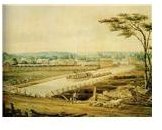Learn About the Building of the Erie Canal: The Facts, Figures & History Behind It
The Erie Canal was one of the marvels of 19th century American engineering. By connecting the Hudson River to Lake Erie, the canal
greatly improved travel and transportation between New York City and the Great Lakes region. When the canal was completed in 1825, there were still no railways or modern highways available so the canal was a very important transportation link, especially for shipping heavy goods.
The idea to build the canal dates back to the 1760s, but the project did not begin until 1808 when the New York State legislature provided funding to survey for the canal. The Erie Canal can be considered one of the most important canals in U.S. history, perhaps second only to the Panama Canal, which connects the Atlantic and Pacific.
Building the Erie Canal
DeWitt Clinton, a mayor of New York City and later governor of New York State, was arguably the most important force behind the building of the Erie Canal. Thanks to his efforts and those of others who supported canal construction, the state legislature provided seven million dollars of funding (well over $100 million in 2009 dollars) in 1817.
When Clinton opened the canal in 1825, the waterway began to have immediate economic impacts. Within fifteen years, New York became America’s busiest port with more freight than Boston, Baltimore and New Orleans combined. Throughout the 1820s, several other canals were built in the state of New York to connect various rivers and lakes. Although some passenger traffic passed through these canals, the canals were primarily used to ship heavy goods such as coal and iron.
Facts and Figures
-
Length: The Erie Canal is 363 miles long.
-
Construction time: The original canal took over ten years to build (1808-1825).
-
Construction methods: The canal was built entirely using human strength and horses; steam and electric-powered machines were not yet available.
-
Daily pay for canal construction workers: $0.80 to $1 per day in 1825.
-
Size of the canal: The original canal was four feet deep and forty feet wide when it opened in 1825.
-
1830s Expansion: In the 1830s, the canal was enlarged to accommodate greater traffic; as a result of this expansion, the canal became seven feet deep and seventy feet wide.
-
1890s expansion: In 1895, further work on the canal was authorized: the canal was deepened to nine feet.
-
20th century expansion: In 1958, the St. Lawrence Seaway was opened which connected the Erie Canal to Lake Erie, the St. Lawrence River and the Atlantic Ocean. This improvement also meant greater shipping traffic between Canada and the United States.
The Locks

Since the land the canal passes through has different elevations, a series of locks were constructed. In particular, the geography of the Niagara Escarpment with its sixty foot rise posed an engineering difficulty. Each canal lock must be opened and closed in order to raise and lower ships as they travel through the Erie Canal. Most canals built in the 19th century used locks but the Erie Canal’s locks are noteworthy for their number and state of preservation; most are still in service.
- Original locks: The first locks built on the canal were designed to hold canal ships 61 feet long and 7 feet wide. The actual locks were ninety feet long and fifteen feet wide.
- Expanded locks: Between 1836 and 1862, the canal locks were expanded to accommodate more ships. Once completed, these expanded locks measured 110 feet long and 18 feet wide.
The Erie Canal Today
The Erie Canal continues to operate in the twenty-first century, but its importance for shipping has declined. With the establishment of railways, airports and the interstate highway system, the canal has competition from other modes of transportation. In 2001, the Erie Canal was designated as a National Heritage Corridor which reinforces the waterway’s historical importance and status. The New York State Canal Corporation operates and maintains the Erie Canal today.
Resources
The Erie Canal, https://www.eriecanal.org/
Erie Canal - 175th Anniversary, https://www.eriecanal.org/UnionCollege/175th.html
The Erie Canal: A Brief History, https://www.canals.ny.gov/cculture/history/index.html
Image Credit: View of Erie Canal by John William Hill, 1829, https://www.history.rochester.edu/canal/
Image Credit: Erie Canal Lock, circa 1912, https://www.eriecanal.org/locks/locks-1912.jpg
